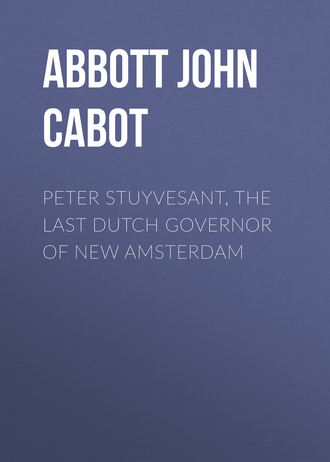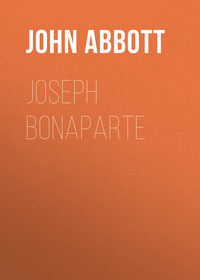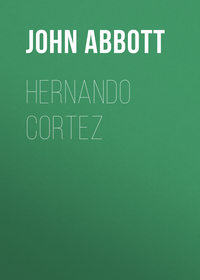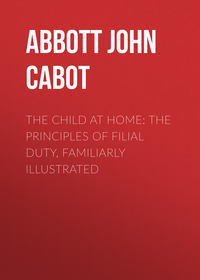 полная версия
полная версияPeter Stuyvesant, the Last Dutch Governor of New Amsterdam
Just then an English non-conformist clergyman, John Davenport, and two merchants from London, men of property and high religious worth, arrived at Boston. They sailed to the Red Rocks, purchased a large territory of the Indians, and regardless of the Dutch title, under the shadow of a great oak, laid the foundations of New Haven. The colony was very prosperous, and, in one year's time, numbered over one hundred souls.
And now the English made vigorous efforts to gain all the lands as far west as the Hudson river. A village of fifty log huts soon rose at Stratford, near the Housatonic. Enterprising emigrants also pushed forward as far as Norwalk, Stamford and Greenwich. The colony at Saybrook consisted in 1640, of a hundred houses, and a fine church. The Dutch now held, in the Connecticut valley, only the flat lands around fort Hope. And even these the English began to plough up. They cudgelled those of the Dutch garrison who opposed them, saying, "It would be a sin to leave uncultivated so valuable a land which can produce such excellent corn."
The English now laid claim to the whole of Long Island, and commenced a settlement at its eastern extremity. In the meantime very bitter complaints were sent to Holland respecting the incapacity of the Director Van Twiller. It was said that he, neglecting the affairs of the colony, was directing all his energies to enriching himself. He had become, it was reported, the richest landholder in the province. Though sustained by very powerful friends, he was removed.
William Kieft was appointed in his stead, the fifth Director. He was a man of very unenviable reputation, and his administration was far from successful. Mr. Brodhead gives the following true and very interesting account of the abundant natural resources of the Dutch settlements on the Hudson at this time:
"The colonists lived amid nature's richest profusion. In the forests, by the water side, and on the islands, grew a rank abundance of nuts and plums. The hills were covered with thickets of blackberries. On the flat lands, near the rivers, wild strawberries came up so plentifully that the people went there to lie down and eat them. Vines, covered with grapes as good and sweet as in Holland, clambered over the loftiest trees. Deer abounded in the forests, in harvest time and autumn, as fat as any Holland deer can be. Enormous wild turkeys and myriads of partridges, pheasants and pigeons roosted in the neighboring woods. Sometimes the turkeys and deer came down to the houses of the colonists to feed. A stag was frequently sold by the Indians for a loaf of bread, or a knife, or even for a tobacco pipe. The river produced the finest fish. There was a great plenty of sturgeon, which, at that time, the Christians did not make use of, but the Indians ate them greedily. Flax and hemp grew spontaneously. Peltries and hides were brought in great quantities, by the savages, and sold for trifles. The land was very well provisioned with all the necessaries of life."6
Thus far, as a general rule, friendly relations had existed between the Dutch and the Indians. But all sorts of characters were now emigrating from the old world. The Indians were often defrauded, or treated harshly. Individuals among the natives retaliated by stealing. When caught they were severely punished. Notwithstanding the government prohibited the sale of muskets to the Indians, so eager were the savages to gain these weapons, so invaluable to them on their hunting-fields, that they would offer almost any price for them. Thus the Mohawks ere long obtained "guns, powder and bullets for four hundred warriors."
Kieft endeavored to tax the Indians, extorting payment in corn and furs. This exasperated them. Their reply, through one of their chiefs, would have done honor to any deliberative assembly. Indignantly the chief exclaimed:
"How can the sachem at the fort dare to exact a tax from us! He must be a very shabby fellow. He has come to live in our land when we have not invited him; and now he attempts to deprive us of our corn for nothing. The soldiers at fort Amsterdam are no protection to us. Why should we be called upon to support them? We have allowed the Dutch to live peaceably in our country, and have never demanded of them any recompense. When they lost a ship here, and built a new one, we supplied them with food and all other necessaries. We took care of them for two winters until their ship was finished. The Dutch are under obligations to us. We have paid full price for everything we have purchased of them. There is, therefore, no reason why we should supply them with corn and furs for nothing. If we have ceded to them the country they are living in, we yet remain masters of what we have retained for ourselves."
This unanswerable argument covered the whole ground. The most illiterate Indian could feel the force of such logic.
Some European vagabonds, as it was afterwards clearly proved, stole some swine from Staten Island. The blame was thrown upon the innocent Raritan Indians, who lived twenty miles inland. The rash Director Kieft resolved to punish them with severity which should be a warning to all the Indians.
He sent to this innocent, unsuspecting tribe, a party of seventy well armed men, many of them unprincipled desperadoes. They fell upon the peaceful Indians, brutally killed several, destroyed their crops, and perpetrated all sorts of outrages.
The Indians never forget a wrong. The spirit of revenge burned in their bosoms. There was a thriving plantation belonging to DeVrees on Staten Island. The Indians attacked it, killed four of the laborers, burned the dwelling and destroyed the crops. Kieft, in his blind rage, resolved upon the extermination of the Raritans. He offered a large bounty for the head of any member of that tribe.
It will be remembered that some years before an Indian had been robbed and murdered near the pond, in the vicinity of the fort at Manhattan, and that his nephew, a boy, had escaped. That boy was now a man, and, through all these years, with almost religious scrupulousness, had been cherishing his sense of duty to avenge his uncle's unatoned death.
A very harmless Dutchman, by the name of Claes Smits, had reared his solitary hut upon the Indian trail near the East river. The nephew of the murdered savage came one day to this humble dwelling, and stopped under the pretence of selling some beaver skins. As Smits was stooping over the great chest in which he kept his goods, the savage, seizing an axe, killed him by a single blow. In doing this, he probably felt the joys of an approving conscience,—a conscience all uninstructed in religious truth—and thanked the great spirit that he had at length been enabled to discharge his duty in avenging his uncle's death.
Kieft sent to the chief of the tribe, demanding the murderer. The culprit Indian sent back the reply:
"When the fort was building some years ago, my uncle and I, carrying some beaver skins to the fort to trade, were attacked by some Dutchmen, who killed my uncle and stole the furs. This happened when I was a small boy. I vowed to revenge it upon the Dutch when I grew up. I saw no better chance than this of Claes Smits."
The sachem refused to deliver up the criminal, saying that he had but done his duty, according to the custom of his race, in avenging the death of his kinsman, murdered many years before. Kieft was exceedingly embarrassed. He was very unpopular; was getting the colony deeper and deeper into difficulty, and was accused of seeking war with the Indians that he "might make a wrong reckoning with the Company."
In this emergency, that others might share the responsibility with him, he reluctantly sought the counsel of the community. Twelve "select men" were chosen to consider the propositions to be submitted to them by the Director. To them the question was propounded:
"Is it not just, that the murder lately committed by a savage, upon Claes Smits, be avenged and punished? In case the Indians will not surrender the murderer, is it not just to destroy the whole village to which he belongs? In what manner, when, and by whom ought this to be executed?"
The result of their deliberations was, in brief, as follows:
"Our harvest is still ungathered; our cattle are scattered in the woods. Many of the inhabitants, unsuspicious of danger, are at a distance. It is not best to precipitate hostilities. In the meantime let two hundred coats of mail be procured in preparation for the expedition. Let our friendly intercourse with the savages be uninterrupted, to throw them off their guard. When the hunting season commences, let two armed bands be sent out to attack the Indians from opposite directions. Let as many negroes as can be spared, be sent on this expedition, each armed with tomahawk and half-pike. Still let messengers be sent once, twice and even a third time to solicit the surrender of the murderer."
The Governor had the reputation of being an arrant coward. It had often been said, "It is very well for him to send us into the field, while he secures his own life in a good fort, out of which he has not slept a single night in all the years he has been here." They therefore shrewdly added, "The Governor himself ought to lead the van in this attack. We will follow his steps and obey his commands."
The hunting season soon came. Still it was decided to delay hostilities. The savages were on their guard. A very general feeling of unfriendliness pervaded the tribes. The Dutch settlers were widely scattered. A combination of the Indians against the colonists might prove an awful calamity. Thus, for a time, the war which was evidently approaching was averted.
CHAPTER V.
WAR AND ITS DEVASTATIONS
Approaching Hostilities.—Noble Remonstrance.—Massacre of the Natives.—The War Storm.—Noble conduct of DeVrees.—The Humiliation of Kieft.—Wide-Spread Desolation.—The Reign of Terror.—State of Affairs at Fort Nassau.—The Massacre at Stamford.—Memorial of the Select Men.—Kieft Superseded by Peter Stuyvesant.
The year 1643 was a year of terror and of blood in nearly all of the American colonies. New England was filled with alarm in the apprehension of a general rising of the Indians. It was said that a benighted traveller could not halloo in the woods without causing fear that the savages were torturing their European captives. This universal panic pervaded the Dutch settlements. The wildest stories were circulated at the firesides of the lonely settlers. Anxiety and terror pervaded all the defenceless hamlets.
DeVrees, rambling one day with his gun upon his shoulder, met an Indian "who was very drunk." Coming up to the patroon, the Indian patted him upon the shoulder, in token of friendship, saying,
"You are a good chief. When we come to see you, you give us milk to drink. I have just come from Hackensack where they sold me brandy, and then stole my beaver skin coat. I will take a bloody revenge. I will go home for my bow and arrows, and shoot one of those rascally Dutchmen who have stolen my coat."
DeVrees endeavored in vain to soothe him. He had hardly reached his home ere he heard that the savage had kept his vow. He had shot and killed an innocent man, one Garret Van Voorst, who was thatching the roof of a house. The chiefs of the tribe were terror-stricken, through fear of the white man's vengeance. They did not dare to go to the fort lest they should be arrested and held as hostages. But they hastened to an interview with DeVrees, in whom they had confidence, and expressed a readiness to make atonement for the crime, in accordance with the custom of their tribe, by paying a large sum to the widow of the murdered man.
It is worthy of notice that this custom, so universal among the Indians, of a blood atonement of money, was also the usage of the tribes of Greece We read in Homer's Iliad, as translated by Pope,
"If a brother bleed, On just atonement we remit the deed; A sire the slaughter of his sons forgives, The price of blood discharged, the murderer lives."At length, encouraged by DeVrees and accompanied by him, the chiefs ventured to fort Amsterdam. They explained to Kieft the occurrence, and proposed the expiatory offering to appease the widow's grief. Kieft was inexorable. Nothing but the blood of the criminal would satisfy him. In vain they represented that he was the son of a beloved chief, and that already he had fled far away to some distant tribe. Our sympathy for these men is strongly excited as we read their sorrowful yet noble remonstrance: "Why," said they,
"will you sell brandy to our young men? They are not used to it. It makes them crazy. Even your own people, who are accustomed to strong liquors, sometimes become drunk and fight with knives. Sell no more strong drink to the Indians, if you will avoid such mischief."
While this question was being agitated, the Mohawks from the upper part of the Hudson, came down in strong military bands, armed with muskets, upon the lower river tribes, attacked them with great ferocity, killed quite a number of their warriors, took the women and children captive, and destroyed their villages.
The lower river tribes all trembled before the terrible Iroquois. Large numbers of these subjugated tribes fled from the river banks, and from the region of Westchester, to Manhattan and to Pavonia, where Jersey City now stands. Here, stripped and panic-stricken, they encamped, "full a thousand strong."
The humane and judicious patroon, DeVrees, in whom the Indians seem to have reposed great confidence, had a beautiful estate several miles up the river, at a place called Vreesendael. It was a delightful spot of about five hundred fertile acres, through which wound a fine stream affording handsome mill seats. The meadows yielded hay enough spontaneously for two hundred head of cattle.
DeVrees, finding his house full of fugitive savages, on their retreat to Pavonia, at the mouth of the river, paddled down in a canoe through the floating ice to fort Amsterdam, to confer with Director Kieft upon the emergency. He urged upon the Director that these poor Indians, thus escaping from the terrible Iroquois and grateful for the protection which the Dutch had not denied them, might easily be won to a sincere friendship. On the other hand, some of the more fiery spirits in the colony thought that the occasion furnished them with an opportunity so to cripple the Indians as to render them forever after powerless. They sent in a petition to Kieft, saying,
"We entreat that immediate hostile measures may be directed against the savages. They have not yet delivered up the assassins of Smits and Van Voorst, and thus these murders remain unavenged. The national character of the Dutch must suffer. God has now delivered our enemies into our hands. Let us attack them. We offer our services, and urge that united parties of soldiers and civilians assail them at several points."
These views were in entire harmony with the wishes of the sanguinary Kieft. He was delighted with the prospect of a war in which victory seemed easy and certain. Disregarding the remonstrances of DeVrees, and of the Christian minister Bogardus, he made efficient preparation for the slaughter of the helpless savages.
He sent his secretary and a military officer across the river to reconnoitre the position of the Indians. There were two bands of these trembling fugitives, one at Pavonia, on the Jersey side of the river, and one at Corlaer's Hook, on the Island of Manhattan, just above fort Amsterdam. Secretly, at midnight of the 25th of February, 1643, the armed bands advanced against their unsuspecting victims. They were sleeping in fancied security when the murderous assault commenced.
"The noise of muskets," writes Brodhead, "mingled with the shrieks of the terrified Indians. Neither age nor sex were spared. Warrior and squaw, sachem and child, mother and babe, were alike massacred. Daybreak scarcely ended the furious slaughter. Mangled victims, seeking safety in the thickets, were driven into the river. Parents, rushing to save their children whom the soldiers had thrown into the stream, were driven back into the waters and drowned before the eyes of their unrelenting murderers."
"I sat up that night," writes DeVrees,
"by the kitchen fire at the Director's. About midnight, hearing loud shrieks, I ran up to the ramparts of the fort. Looking towards Pavonia, I saw nothing but shooting, and heard nothing but the shrieks of Indians murdered in their sleep."
With the dawn of the morning the victorious Dutch returned from their scene of slaughter, bearing with them about thirty prisoners, and the heads instead of the scalps of many warriors. Kieft welcomed these blood-stained men with "shaking of hands and congratulations." The tidings of this outrage spread far and wide among the Indian tribes in the valley of the Hudson and on the Long Island shore.
Private enterprise, relying upon the protection of Kieft, had sent out a foraging expedition upon Long Island. Kieft assumed that he saw signs of hostility there. The unsuspecting savages were plundered of two wagon loads of grain. These Indians, who had thus far been the warmest friends of the Dutch, were now justly roused to the highest pitch of indignation. They immediately made common cause with the river tribes, who were almost frenzied with the desire to avenge the midnight massacres of Pavonia and Manhattan. The storm which thus burst upon New Netherland was sudden and awful. The savages, in their rage, developed energy and power totally unanticipated.
Eleven tribes combined in the most furious and merciless attacks upon the lonely farm-houses. Everywhere the war-whoop resounded, and the plumed and painted savages emerged from swamps and thickets, and assailed every unprotected dwelling. The farmer was shot in the field, his dwelling burned, and his wife and children were thrown into the flames. Many women and children, their lives being spared, were carried into captivity worse than death. Houses, haystacks and granaries were fired. Cattle were slain or driven off, and crops destroyed.
Terror held high carnival. From the banks of the Raritan to the valley of the Housatonic, over a region of hundreds of square miles, not a plantation was safe. Men, women and children, haggard with hunger, exposure and woe, fled from their deserted homes to fort Amsterdam. Despairing of ever again finding peaceful residence in this new world, with one voice they demanded a return to the fatherland. The Dutch colonies were threatened with immediate and entire depopulation.
Kieft himself was terrified in view of the frightful storm he had raised. He was compelled to enlist every able-bodied man as a soldier. There was an end to all traffic, to all agriculture, to all the arts of industry. Even the plantation of the humane DeVrees did not escape the undiscriminating wrath of the savages. The outhouses, cattle and crops were utterly destroyed. Quite a number of the terrified colonists had taken refuge in the manor house which DeVrees had prudently built very strong, and constructed with loopholes for musketry.
The Indians were besieging the place, when one of their tribe came, whom DeVrees had assisted to escape from the massacre at Manhattan. He told the story of his escape and said that DeVrees was a good chief whom they ought to respect. The Indians held a short consultation, and then the grateful savages deputed one of their number to advance within speaking distance of the manor house. This man, whom we call a savage, cried out:
"We are very sorry that we have destroyed the outhouses, the cattle and the crops. We now know that chief DeVrees is a good chief and our friend. If we had not destroyed his property we would not do so. We will not harm the brewery, though we all greatly need the copper kettle to make barbs for our arrows."
These noble red men, for we must think they exhibited a noble spirit, then departed. DeVrees was, at the time, in the manor house. He hastened down the river to fort Amsterdam and indignantly addressing the governor, said: "Has it not happened just as I foretold, that you are only helping to shed Christian blood? Who will now compensate us for our losses?"
The wretched Kieft had not one word to reply. He however, made a weak and unavailing attempt to appease the wrath of the Long Island Indians. But the roaring tornado of savage vengeance could not thus be divested of its terrors. The messengers he sent, approaching a band of Indians, cried out to them, "We come to you as friends." They shouted back contemptuously, "Are you our friends? You are only corn thieves." Refusing all intercourse they disappeared in the forest.
During all these scenes the infamous and cowardly Kieft ensconced himself securely within the walls of the fort. The bewailings of ruined farmers, and of widows and orphan children rose all around him. To divert public clamor, he fitted out several expeditions against the Indians. But these expeditions all returned having accomplished nothing.
"The proud heart of the Director," writes Brodhead,
"began to fail him at last. In one week desolation and sorrow had taken the place of gladness and prosperity. The colony entrusted to his charge was nearly ruined. It was time to humble himself before the Most High, and invoke from heaven the mercy which the Christian had refused the savage.
"A day of general fasting and prayer was proclaimed. 'We continue to suffer much trouble and loss from the heathen, and many of our inhabitants see their lives and property in jeopardy, which is doubtless owing to our sins,' was Kieft's contrite confession, as he exhorted every one penitently to supplicate the mercy of God, 'so that his holy name may not, through our iniquities, be blasphemed by the heathen.'"
The people still held the Director responsible for all the consequences which had followed the massacres of Pavonia and Corlaer's Hook. They boldly talked of arresting and deposing him, and of sending him, as a culprit, back to Holland. The Director, panic stricken, endeavored to shift the responsibility of the insane course which had been pursued, upon one Adriansen, an influential burgher, who was the leading man among the petitioners who had counselled war.
Adriansen was now a ruined man. His own plantation had been utterly devastated. Exasperated by his losses, he had no disposition to take upon himself the burden of that popular odium which had now become so heavy. Losing all self-control, he seized a sword and a pistol, and rushed into the Director's room, with the apparent intention of assassinating him, exclaiming, "what lies are these you are reporting of me."
He was disarmed and imprisoned. One of his servants took a gun, went to the fort and deliberately discharged the piece at the Director, but without hitting him. The would-be assassin was shot down by a sentinel and his head exposed upon the scaffold. Adriansen was sent to Holland for trial.
After terrible scenes of suffering, a temporary peace was restored through the heroic interposition of DeVrees. He was the only man who dared to venture among the exasperated Indians. They watched over him kindly, and entreated him to be cautious in exposing himself, lest harm might befall him from some wandering Indians by whom he was not known. But the wrongs which the Indians had experienced were too deep to be buried in oblivion. And there was nothing in the character of Kieft to secure their confidence. After the truce of a few weeks the war, without any imaginable cause, broke out anew.
All the settlements at Westchester and Long Island were laid waste. Scarcely an inhabitant, save the roving Indian, was to be found in those regions. The Dutch were driven out of the whole of New Jersey. The settlers on Staten Island were trembling in hourly expectation of an assault. War's devastating surges of flame and blood swept nearly the whole island of Manhattan. Bold men ventured to remain well armed, upon a few of the farms, or boweries as they were called, in the immediate vicinity of the fort, but they were continually menaced with attack, night and day. A bowery was a farm on which the family resided. A plantation was one of those extended tracts of land, which was partly cultivated but upon which no settler dwelt. There was no protection anywhere for the trembling population, save in and directly around fort Amsterdam. Mr. Brodhead, alluding to these scenes of terror, writes,
"The women and children lay concealed in straw huts, while their husbands and fathers mounted guard on the crumbling ramparts above. For the fort itself was almost defenceless. It resembled rather a mole-hill than a fortress against an enemy. The cattle, which had escaped destruction, were huddled within the walls, and were already beginning to starve for want of forage. It was indispensable to maintain a constant guard at all hours, for seven allied tribes, well supplied with muskets, powder and ball, which they had procured from private traders, boldly threatened to attack the dilapidated citadel with all their strength, now amounting to fifteen hundred men.











